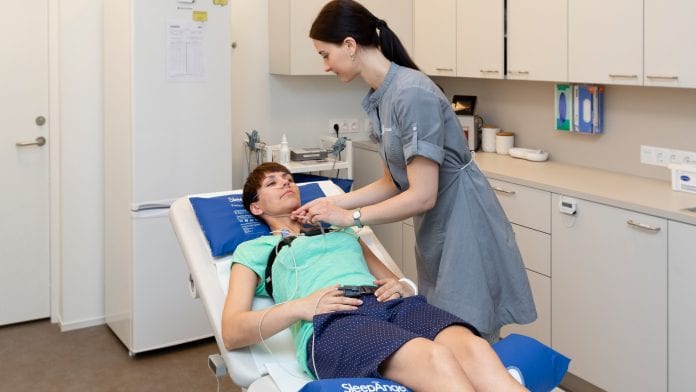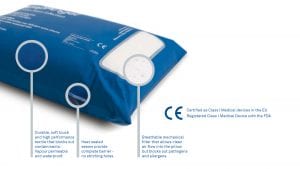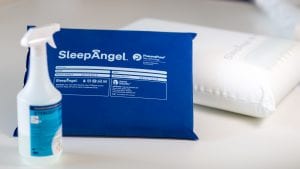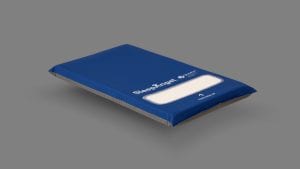
Coronavirus cannot enter pillows and mattresses that are equipped with SleepAngel PneumaPure filters. Silver Türk (PhD, medical microbiology) explains the infection control benefits of SleepAngel bedding products.
Healthcare-associated infections combined with antibiotic resistance present a global challenge that brings hygiene and prevention into sharper focus. One area which is often overlooked is soft surfaces, which act as a link in a chain of cross-infection between patients and caregivers.
The infected pillow has several things in common with the infected human in terms of its capacity to spread infection. The human being coughs and sneezes, thereby generating a periodic aerosol of contaminated material into the ambient surroundings. The conventional coated pillow with stitched seams does something very similar: approximately two litres of humid air contaminated with microorganisms carried in droplet suspension are aerosolised into the environment, every time the patient’s head is placed on the pillow.
This has the capacity to recolonise the nearby environment, negating the effectiveness of any cleaning regimen. Infected pillows are likely to be a significant vector for infection, and the introduction of a CE marked, validated barrier pillow, alongside an audit protocol which considers pillows and their serviceable condition, is a simple, inexpensive, and prudent measure1.
Persistence of pathogens on the surface and the inside of objects
Microorganisms can persist on common hospital surfaces for up to several weeks or months2. In contrast to evidence regarding hard surfaces, relatively few studies have focused on textiles. Pillow seams and care labels that are attached by stitching to the pillow form the most significant vector for pathogens3.
When the head is lifted from the pillow, air flows into the pillow and can contaminate the interior; when the head is laid on the pillow or is moved, air escapes the pillow and can contaminate the exterior – in effect, an aerosol generating procedure. Similarly, liquid-borne pathogens resulting from fluids generated during surface cleaning enter and exit through the seam stitching holes. Pathogens can contaminate both the surface and interior of traditional pillows and mattresses. Conversely, only the surface remains accessible to pathogens if a nanoporous pathogen filter is used – in conjunction with hermetically sealed textiles – as a barrier that blocks the viruses but lets the air pass. The filter is necessary on a sealed pillow, since it would otherwise be unable to deflate and conform for the patient’s comfort. Infectious agents can enter the traditional pillows and mattresses via vents and sewing holes, whereas pillows and mattresses with nanoporous pathogen filters block such mechanisms of contamination.

What is known about coronaviruses?
While it is known that bacteria can contaminate the interior of pillows and filters can prevent this4, there is scant information on viral contamination. COVID-19 has shown person-to-person transmission; and has higher infectivity but lower mortality compared to its close relatives severe acute respiratory syndrome (SARS) and Middle East respiratory syndrome (MERS). The route of transmission is mainly via airborne particles, but transmission from surface contamination to mucous membranes of eyes, nose and mouth should not be disregarded.
22 studies have investigated persistence of these reasonably similar coronaviruses. The viral particles can retain their infectivity on hard surfaces like metal, glass or plastic for up to nine days but can be inactivated within one minute of applying 70% ethanol, 50% isopropanol, 0.5% hydrogen peroxide or 0.1% bleach, while common nonionic surfactants are less effective5; importantly for equipment, glutaraldehyde disinfection was also effective. In typical room temperature and relative humidity, the viral kin of COVID-19 seem to persist on hard surfaces for days5,6. In hospitals, the known risk factors of transmission are low air exchange, small isolation room volume and aerosol generating procedures such as resuscitation, tracheal intubation, non-invasive ventilation, tracheotomy, manual ventilation, and bed distances of less than 1m7.
With regard to face masks, N95 masks were more effective barriers than the surgical masks – with the caveat of sideways leakage that bypasses the filter. A visual technique that can be used for contamination risks, principally, is to use inhaled smoke as a substitute for viral particles8. Gowns, N95 respirators, face masks, gloves, eye protection, face shields, and head and shoe coverings can be used for protection with variable results, but it is safer to assume that careful high level biosafety measures including also a dedicated decontamination area should be adopted9.
What can be generalised from other studies done with viruses?
The differences between textiles matter a lot – it is known that polio virus (inoculated with direct contact, aerosol and contaminated dust) persists at 35% relative humidity for 20 weeks on wool fabrics but only one to four weeks on cotton fabrics10. Disinfectants are different – polio virus is largely resistant to quaternary ammonium salts, while some of these compounds killed vaccinia virus11. This antiviral activity is probably broad as it is oxidation-mediated, and it is shown that it can inactivate HIV as well12. Antiviral plastics have been researched – a polyurethane that can neutralise the influenza virus (but not polio virus) has been described13. Cotton treated with 3% sodium pentaborate pentahydrate and 0.03% triclosan reduced the viral titres by thousand times within 72 hours in comparison to no reduction on untreated cotton14.
While there is no data on persistence of the coronavirus on soft textile surfaces or, worryingly, interior of soft textile objects from the perspective of disinfection, it is known that common glass, steel, silicone rubber and polyvinyl chloride permit the persistence of the less pathogenic coronavirus 229E for at least five days while copper or copper alloys inactivate the virus within minutes by means of copper ion mediated oxidation15.
Importantly, aerosol and surface stability of the coronavirus causing the current COVID-19 has been investigated. The two strains were quite similar. It was found that the surfaces were permissible for infectivity of virus particles in the following order: plastic > steel >> cardboard > copper – viral titres reduced within days on plastic and steel while no virus was detectable on cardboard and copper after eight and four hours, respectively16. The typical filling materials for pillows are polyester fibres and polyurethane foams: both plastics which are cellular by nature and humid by application. It has been demonstrated that pillow interiors can act as reservoirs for pathogens17,18 including viral pathogens like norovirus. Therefore, a common sense infection prevention assessment should highlight pillows as a fomite risk.
Antiviral activity of impregnated textiles against the novel coronavirus 2019 (nCoV-19) currently is more speculative: either the antiviral activity must be very broad and potent, or a coronavirus-specific study is necessary for clarity.
According to recent testing by an independent laboratory, PneumaPure filters can block transmission of coronavirus 229E. Hence, this filter can also protect the interiors of pillows and mattresses from nCoV-19 contamination, thereby eliminating the fomite risk posed by contaminated soft surface interiors and ensuring a safer environment for caregiver and patient.
PneumaPure filtered pillows – barrier to pathogens, allergens, liquids and (corona)virus
SleepAngel barrier bedding, developed by Gabriel Scientific, features PneumaPure filter technology. This technology enables the pillow to ventilate, so it is comfortable to use, but prevents the passage of liquid and airborne pathogens that colonise the interior of standard bedding products. The SleepAngel pillow differs from standard occlusive pillows in that the seams are high frequency welded to make a seal, as opposed to stitched. The absence of stitching holes prevents ingress of contaminated air or fluid via the seams. Instead, only clean air passes in and out of the pillow via a waterproof microbial filter, which has been tested to prevent ingress of bacteria, fungi, and viruses as small as 25 nanometres19.
Laboratory validation shows barrier pillows to be impervious to pathogens, where standard pillows become quickly colonised by organisms with many months’ longevity. Samples taken from pillows in service demonstrate a bioburden in standard pillow interiors which is comprehensively eliminated in barrier pillows. Environmental contamination is known to take place by aerosolisation via the pillow; and increased environmental contamination is known to result in increased transmission and increased rates of infection.

NHS Wales adopts SleepAngel bedding to protect patients and caregivers
Betsi Cadwaladr University Health Board (BCUHB) is Wales’s biggest Health Board and one of the largest in the UK, providing healthcare to 22% of the Welsh population.
The Health Board has recently invested in CE Medical Device barrier bedding by equipping its hospitals with SleepAngel mattresses, pillows and duvets. The Health Board has purchased Sleepangel’s industry leading, clinically proven bedding range to help support its ‘Safe Clean Care’ infection prevention programme which has been implemented to reduce infection risk and provide a safe clean environment for patients and caregivers. There has always been a significant need to ensure a safe environment for patient care; and due to recent challenges around COVID-19 it has become more essential than ever before that soft surfaces used in healthcare provide the correct barrier to protect patient and caregivers.
Paul Clarke, Head of Facilities at BCUHB, commented: “Prior to being introduced to the SleepAngel products my understanding of soft surfaces was, I’m sure, the same as everyone else; especially in regard to a pillow or mattress. It is not until you see the innovation used by SleepAngel with the use of the PneumaPure Filter technology that you understand the difference between a standard washable product and a world class medical device.”
Initial results of extensive testing demonstrate PneumaPure’s efficacy at North Shore University Hospital
Before COVID-19 was a concern in the US, North Shore University Hospital – part of Northwell Health, the largest healthcare provider in the state of New York – recognised that soft surface contamination could put patients and caregivers at risk.
After confirming that previously used stitched hospital pillows still had traces of human and bacterial DNA present in their inner core, North Shore University Hospital decided to test the efficacy of PneumaPure filtered pillows. Initial results of the ongoing study have shown that at the end of a six-month period of active use involving all patient units and the ER, no bacteria were detected in the interiors of any PneumaPure pillows tested.
After recognising the PneumaPure filtered pillow as a safer alternative, Northwell Health began integrating them into other facilities within their system: “When COVID-19 came our way, our children’s hospital made a decision to change all our pillows to [PneumaPure filtered] pillows. We hope this will be one of many necessary steps that help prevent viral spread. I urge all hospitals to share new technologies, innovations, successes and failures, now and in the future,” said North Shore’s Assistant Director Mary Brennan RN, MBA, CWON.
The above testing was managed by Spry Therapeutics, the distributor of the PneumaPure filter in the USA.

References
1 Turk et al, 2017
2 Kramer A, Schwebke I, Kampf G. How long do nosocomial pathogens persist on inanimate surfaces? A systematic review. BMC Infect Dis. 2006;6:130.
3 Mottar R, Roth M, Allen M, Gerber R, Gerber BR. (2006). Pillow Talk. Examining Pillow Cores In A Regional Burn Center. Am J Infect Control, 34(5), E107–E108.
- Türk S, Christersson J, Rööp T, Didenko D. Comparison of bacterial loads of two types of hospital pillows: perspectives of improving hospital hygiene standards. Can J Infect Control. 2017 32; 112-14.
5 Kampf G, Todt D, Pfaender S, Steinmann E. Persistence of coronaviruses on inanimate surfaces and their inactivation with biocidal agents. J Hosp Infect. 2020 Mar;104(3):246-251.
6 Geller C, Varbanov M, Duval RE. Human coronaviruses: insights into environmental resistance and its influence on the development of new antiseptic strategies. Viruses. 2012 Nov 12;4(11):3044-68.
7 Casanova LM, Jeon S, Rutala WA, Weber DJ, Sobsey MD. Effects of air temperature and relative humidity on coronavirus survival on surfaces. Appl Environ Microbiol. 2010 May;76(9):2712-7.
8 Hui DS. Severe acute respiratory syndrome (SARS): lessons learnt in Hong Kong. J Thorac Dis. 2013 Aug;5 Suppl 2:S122-6.
9 Chaovavanich A, Wongsawat J, Dowell SF, Inthong Y, Sangsajja C, Sanguanwongse N, Martin MT, Limpakarnjanarat K, Sirirat L, Waicharoen S, Chittaganpitch M, Thawatsupha P, Auwanit W, Sawanpanyalert P, Melgaard B. Early containment of severe acute respiratory syndrome (SARS); experience from Bamrasnaradura Institute, Thailand. J Med Assoc Thai. 2004 Oct;87(10):1182-7.
10 Dixon GJ, Sidwell RW, McNeil E. Quantitative studies on fabrics as disseminators of viruses. II. Persistence of poliomyelitis virus on cotton and wool fabrics. Appl Microbiol. 1966 Mar;14(2):183-8.
11 Sidwell RW, Dixon GJ, McNeil E. Quantitative studies on fabrics as disseminators of viruses. 3. Persistence of vaccinia virus on fabrics impregnated with a virucidal agent. Appl Microbiol. 1967 Jul;15(4):921-7.
12 Borkow G, Lara HH, Covington CY, Nyamathi A, Gabbay J. Deactivation of human immunodeficiency virus type 1 in medium by copper oxide-containing filters. Antimicrob Agents Chemother. 2008 Feb;52(2):518-25.
13 Park D, Larson AM, Klibanov AM, Wang Y. Antiviral and antibacterial polyurethanes of various modalities. Appl Biochem Biotechnol. 2013 Feb;169(4):1134-46.
14 Iyigundogdu ZU, Demir O, Asutay AB, Sahin F. Developing Novel Antimicrobial and Antiviral Textile Products. Appl Biochem Biotechnol. 2017 Mar;181(3):1155-1166.
15 Warnes SL1, Little ZR1, Keevil CW2. Human Coronavirus 229E Remains Infectious on Common Touch Surface Materials. mBio. 2015 Nov 10;6(6):e01697-15.
16 van Doremalen N, Bushmaker T, Morris DH, Holbrook MG, Gamble A3, Williamson BN, Tamin A, Harcourt JL, Thornburg NJ, Gerber SI, Lloyd-Smith JO, de Wit E, Munster VJ. Aerosol and Surface Stability of SARS-CoV-2 as Compared with SARS-CoV-1. N Engl J Med. 2020 Mar 17.
17 Kaiser T, Finstermeier K, Häntzsch M et al, Stalking a lethal superbug by whole-genome sequencing and phylogenetics: Influence on unraveling a major hospital outbreak of carbapenem-resistant Klebsiella pneumoniae. Am J Infect Control. 2018 Jan;46(1):54-59.
18 Chen Y, He Y, Zhang W, et al Pathogenic characteristics of nosocomial infections in patients with cerebrovascular diseases and characteristics and treatment of pathogenic bacteria in different seasons. J Infect Public Health. 2019 Dec 9.
19 Airmid Laboratories report, 2013

SleepAngel Medical
Gabriel Scientific OÜ
+372 5811 9997
info@SleepAngel-Medical.com
This article is from issue 14 of Health Europa. Click here to get your free subscription today.










